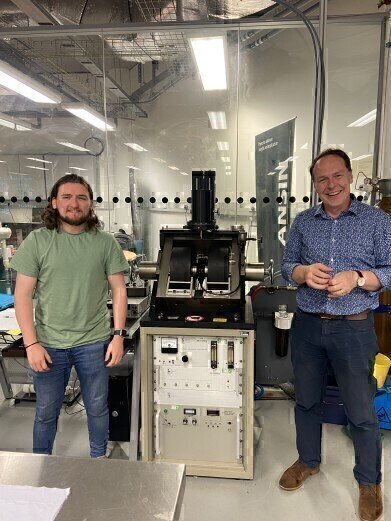-
 Coner McCluskey (left) and Professor Marty Gregg
Coner McCluskey (left) and Professor Marty Gregg
News & Views
Historical Method paves way for Smarter Electronics
Aug 29 2022
Research students at Queen’s University Belfast have used modified experimental geometry originally dating back to 1911, to measure for the first time the exact electronic properties of a “domain wall” - nanoscale, two-dimensional sheets embedded in crystalline material - which can be more electrically conducting than the surrounding crystal itself. Useful as nanoscale electrical connections, they can also be created, destroyed and moved around - holding promise for completely reconfigurable new devices with ability to change function entirely or self-heal if broken.
Conor McCluskey, one of the students who led the experiment in the School of Mathematics and Physics at Queen’s, said: “We now know that the electrons that carry the electrical current within these domain walls move exceptionally fast at room temperature. They move at similar speeds to the electrons in graphene - which is a wonder material hailed for its conduction properties and its discovery warranted a Nobel prize in 2004.
“Usually when an electron is carrying a current it eventually scatters off the atoms in the material. This blocks the electron on its journey and creates electrical resistance. We have found that charges in these domain walls can move for a very long time before they get scattered - on average they move quite fast. This property itself is quite useful for high-speed electronics, but combined with the fact that the domain walls themselves are entirely mobile and reconfigurable could be a game changer for nanotechnology.”
Conor added that while electronic components have become smaller and smaller, the point has been reached where further reduction in size would affect the reliability of the components. “The next generation of devices will need to rely on materials which do something different and mobile domain walls might offer us just that. Our discovery sheds some light on exactly what is happening in these domain walls to make them behave the way they do, and this understanding is key to creating real domain wall devices that work reliably.”
Professor Marty Gregg, School of Mathematics and Physics at Queen’s comments: “There’s a great analogy from Professor Nava Setter, a pioneer in domain wall research, to describe the potential applications of domain walls in nanoelectronics. You can think of an electrical circuit as a city, a complex layout of buildings, all linked together by roads.
“Similarly, a circuit has electronic components linked together by electronic connections. If these electrical connections are instead provided by mobile and reconfigurable domain walls, it would be like having the ability to change the layout of the city roads in an instant, allowing you a direct path to your destination. Now, we are beginning to reveal the true electronic properties of the domain walls themselves. Rather than simply acting as connections, it seems like they can act as the functional components themselves. Sticking to the analogy, we can move and recreate the actual buildings in the city, rather than just the connections between them.”
He adds: “With circuits that can reconfigure or repair themselves, we could have tiny electronic devices that are extremely flexible and adaptable. This could make a huge difference to society. For example, the ability to repair electronic devices which are not easy to access, such as in medical implants, or onboard satellites in orbit, that would be a huge benefit.”
The Queen’s University team worked in collaboration with teams from France (Dr Manuel Bibes), the US (Professor Alexei Gruverman), and the Republic of Ireland (Professor Ursel Bangert). The findings have been published in Advanced Materials
More information online
Digital Edition
Lab Asia 31.2 April 2024
April 2024
In This Edition Chromatography Articles - Approaches to troubleshooting an SPE method for the analysis of oligonucleotides (pt i) - High-precision liquid flow processes demand full fluidic c...
View all digital editions
Events
Apr 22 2024 Marrakech, Morroco
Making Pharmaceuticals Exhibition & Conference
Apr 23 2024 Coventry, UK
Apr 23 2024 Kintex, South Korea
Apr 23 2024 Seoul, South Korea
Apr 24 2024 Jakarta, Indonesia



.jpg)













